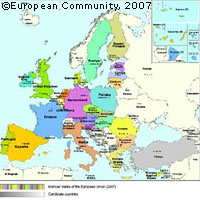Do more to encourage investment of Structural Funds in research, says EURAB
The European Research Advisory Board, EURAB, has called for measures to increase the use of Structural Funds for enhancing research and innovation. 'We must increase the resources dedicated to research and innovation measures by Structural Fund Programmes; we must raise awareness of the importance of actions in this area; spread experience and best practice of how to deliver economic benefits from these measures, and we must ensure that Structural Fund actions are firmly embedded within the wider research and innovation 'eco-system',' reads the latest EURAB report. The report starts from the premise that the knowledge triangle of research, education and innovation is central to achieving the Lisbon goal of making Europe's economy the most competitive in the world by 2010. But if the goal is to be achieved, the knowledge triangle must first be 'energised', which EURAB suggests can be done through the EU's Structural Funds - the Commission's programme for investment the EU's less advantaged regions. Indeed the Commission has already seen the advantages that the Structural Funds. Two European Commissioners (Janez Potocnik, Research; and Danuta Hübner, Regional Policy) have expressed their wish to see Member States and their regions earmarking some of their Structural Fund resources for research and innovation. Structural Funds could stimulate research and innovation activity by increasing a region's capacity for undertaking research through investment in infrastructure or the workforce. The additional funding could also be used to support the commercialisation of research results, to strengthen governance arrangements for research and innovation, and to introduce an international dimension to a region's activities by supporting access to trans-national programmes such as FP7. The EURAB report makes nine recommendations on how to use the Structural Funds to boost research and innovation. Among the recommendations is a call for incentives to encourage a greater take-up of research and innovation activity through the Structural Funds, such as differential grant rates, or the establishment of awards for regions that demonstrate investment in research and innovation through the Structural Funds. EURAB also supports a recommendation that came out of the Aho Report, that recipients of the Structural Funds should be obligated to set aside significant share of the funds, perhaps around 20%, for investment in research and innovation. Another specific recommendation is that consideration be given to the idea of reducing the amount of national or regional funding that recipients are required to invest in projects supported through the Structural Funds. The level of national or regional funding could drop to 10%, from the current 50% or 25%, suggests EURAB. EURAB would also like to see incentives within the Structural Funds to encourage the use of new financial instruments available from the European Investment Bank (EIB). Grants could be used, for example, to cover the interest payments on research infrastructure. The report also suggests making stronger links between the Structural Funds and the Seventh Framework Programme for research and technological development (FP7). This could have pay-offs in both directions, says EURAB: actions supported through the 'Capacities' section of FP7 could influence the development of relevant actions supported by the Structural Funds, while the Structural Fund programmes could, in turn, lay the foundations for future participation in the framework programmes. In fact, the Structural Funds already receive several mentions in the Decision on FP7. For example, proposals for infrastructure projects will be judged according to a number of criteria, including the potential for using EIB loans and Structural Funds for additional support. Under the heading of 'Research Potential', the document also explains that 'Strong synergies will be sought with Community regional policy. Actions supported under this heading will identify needs and opportunities for reinforcing the research capacities of emerging and existing centres of excellence in convergence regions which may be met by structural and cohesion funds.' 'We recognize that a valuable proportion of the Structural Funds are already dedicated to stimulating research and innovation in the EU,' reads the EURAB paper. 'However, we believe that more can still be done in order to realise the common aims of the Commissioner for Regional Policy and Member States to dedicate a substantial share of the Structural Funds to research and innovation. We call upon the European Commission, the Member States and regional authorities to seek to deliver this objective.'



